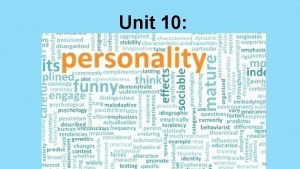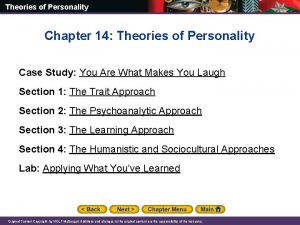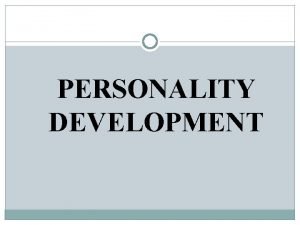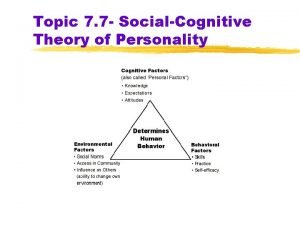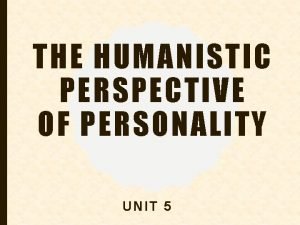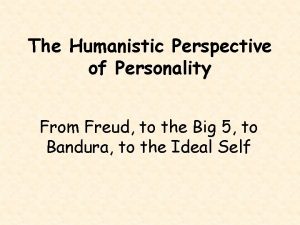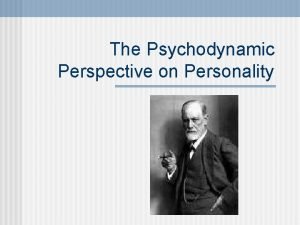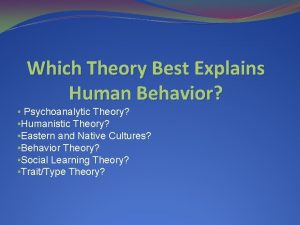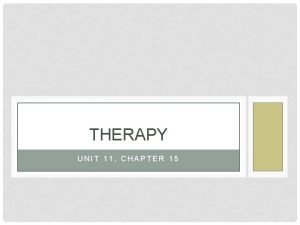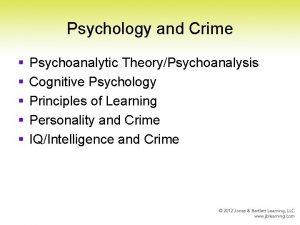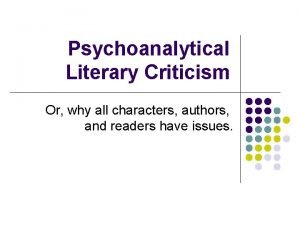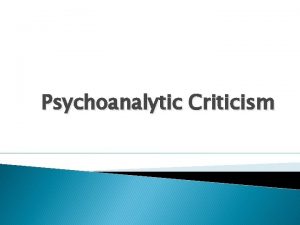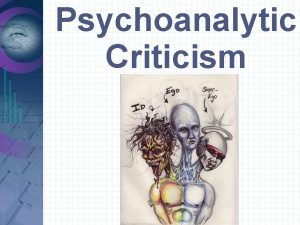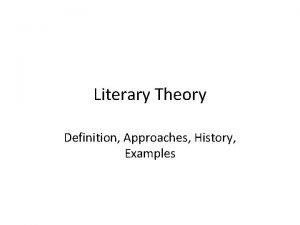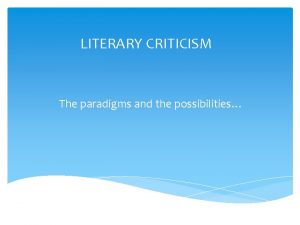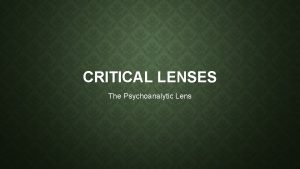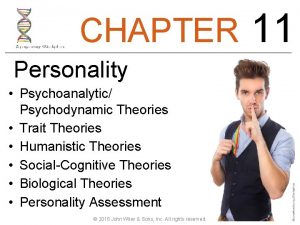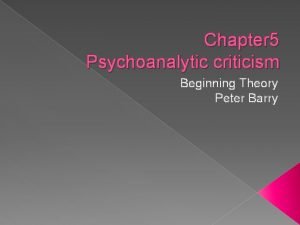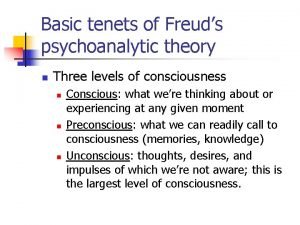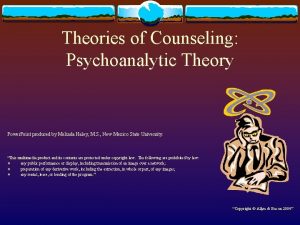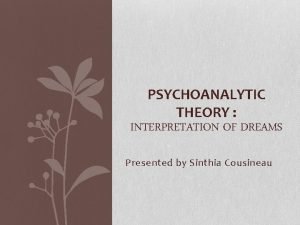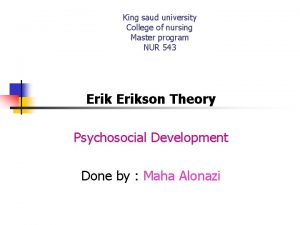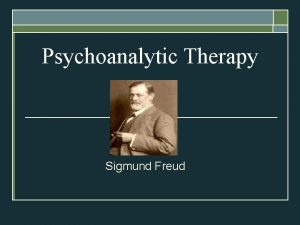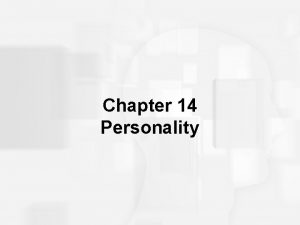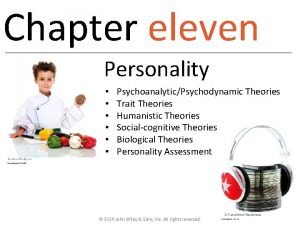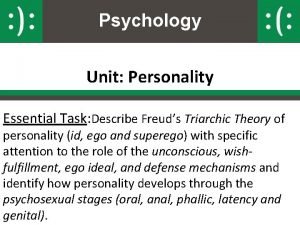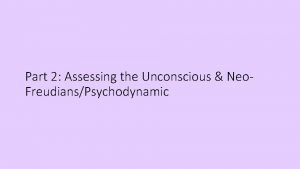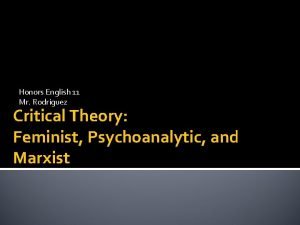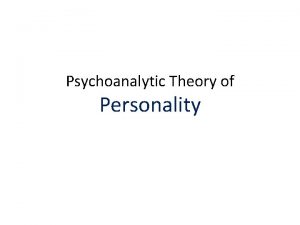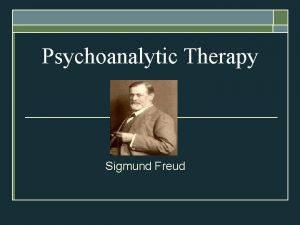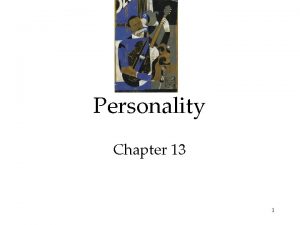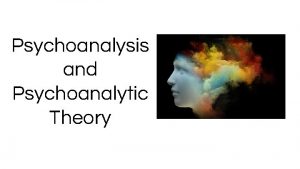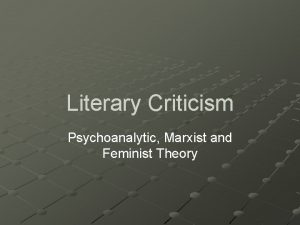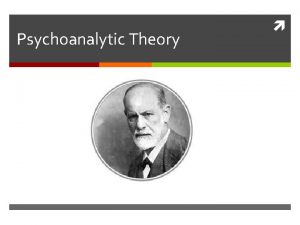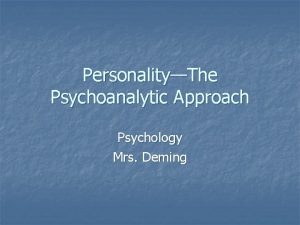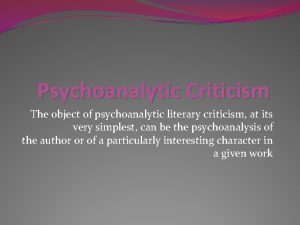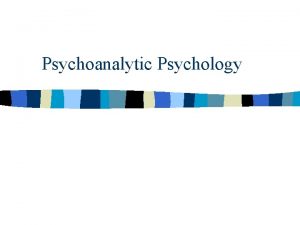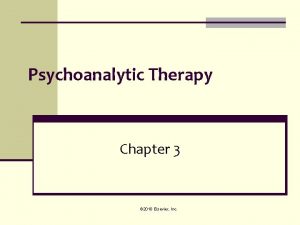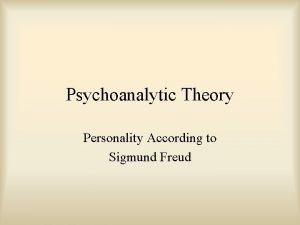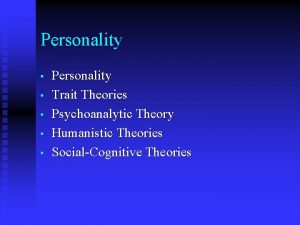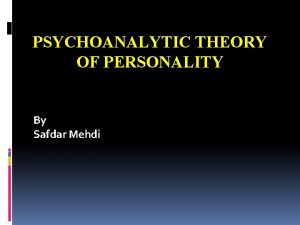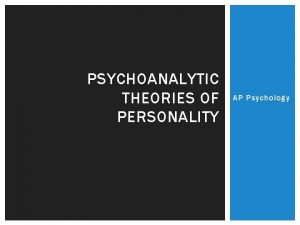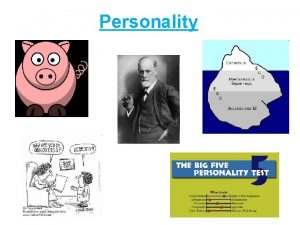Personality and The Psychoanalytic Perspective Personality and the









































- Slides: 41

Personality and The Psychoanalytic Perspective •

Personality and the Four Perspectives • Personality refers to your characteristic pattern of thinking, feeling, and acting. • Theories of Personality you Must Know: 1. Psychoanalytic 2. Trait 3. Humanistic 4. Social Cognitive

The Psychoanalytic Perspective • Mostly based on the ideas of Sigmund Freud. • Freud argued that personality was mostly influenced by unconscious conflicts/motivations and early childhood sexuality/experiences. • 2 most basic motives were sex and aggression.

The Psychoanalytic Perspective • Psychoanalysis: specifically refers to Freud’s theory on unconscious motivations influence on our personality and to the techniques used to uncover and interpret unconscious conflicts and tensions which may be causing a psychological disorder. • From his viewpoint, only through understanding your unconscious conflicts can you overcome psychological problems like depression, anxiety, etc.

Unconscious vs. Preconscious Unconscious: • According to Freud is a reservoir of mostly unacceptable thoughts, wishes, feelings and memories we are unaware of. • Contemporary viewpoint- information processing of which we are unaware Preconscious: information that is not conscious, but is retrievable into conscious awareness. Ex: phone number, best friend’s last name, etc.

Structure of Our Personality According to Freud Ego Conscious mind Unconscious mind Superego Id • To Freud, Personality is like an iceberg. • We can only see a very small part of it (conscious) while most of it is unseen (unconscious)

Parts of Personality According to Freud • Id: largest part of your personality that is unconscious, largely instinctual, and purely operates to satisfy biological, sexual, and aggressive drives. • Seeks immediate gratification and operates according to the pleasure principle.

Parts of Personality According to Freud • Superego: part of personality that develops around the age of 4 to 5. • It is your voice of conscience and focuses on the morality principle: how you should act according to ideals. • It provides standards for judgment and future aspirations; pushes you towards perfection.

Parts of Personality According to Freud • Ego: the largely conscious part of your personality that mediates conflict between your id and superego. • Operates according to the reality principle satisfying the id’s desires in ways that will realistically bring pleasure rather than pain.


Your Personality Arises From Conflict Between Pleasure Seeking Impulses (Id) and Internalized Social Restraints (Superego) Against Them


Personality Development • According to Freud, personality develops during the first few years of life. He believed that an adult’s conflicts are rooted in unresolved conflicts from early childhood which were often related to conflicts in psychosexual development. • Psychosexual Stages: childhood stages of development during which according to Freud, the id’s pleasure seeking energies are focused on distinct erogenous zones.

Know the Psychosexual Stages Freud’s Psychosexual Stages Stage Focus Oral (0 -18 months) Pleasure centers on the mouth-sucking, biting, chewing Anal (18 -36 months) Pleasure focuses on bowel and bladder elimination; coping with demands for control Phallic (3 -6 years) Pleasure zone is the genitals; coping with incestuous sexual feelings Latency (6 to puberty) Dormant sexual feelings Genital (puberty on) Maturation of sexual interests

Personality Development and Conflict • Fixation: refers to a lingering focus of pleasure seeking energies at an earlier psychosexual stage. Occurs when those “sexual needs” are overindulged or deprived. – Ex: Anal Retentive, etc.

Conflict/Fixation in the Oral Stage • Oral stage focuses on “sexual pleasure” infant gets from sucking, biting, and chewing. • Conflict arises when child is weaned off of breast or bottle, which in some cases causes traumatic separation anxiety. • Fixation in this stage leads to: 1. Oral dependent personality: gullible, passive, dependent or 2. Oral aggressive personality: sarcastic, argumentative personality. • Adults fixated may smoke, drink, chew pens, or have other oral habits when they get anxious.

Conflict/Fixation in the Anal Stage • Anal stage focuses on “sexual pleasure” child receives from being able to control defecation (pooping) at the anus. • Conflict arises during toilet training. Child may become fixated if training is too strict and inflexible or too lenient. • Fixation in this stage leads to: 1. Anal retentive personality: compulsive cleanliness, orderliness, etc. OR Anal Expulsive personality: disorganized, messy, hot temper.

Conflict/Fixation During the Phallic Stage (Focus on Genitals) • The Oedipus Complex: boys develop sexual desires towards their mothers and feelings of jealousy and hatred towards their father…Little Hans Case Study • Fear of punishment from their father leads to castration anxiety and eventual repression of feelings towards mother and identification with rival parent (father). • Identification: process by which children incorporate their parents’ values into their developing superegos. • Remember to Mention Electra Complex.

Latency Stage • From age 6 to 12, sexual feelings are repressed. • Freud argued this was the stage in which children put energy into forming social relationships and learning new tasks. • If child does not fulfill their own expectations they may feel inferior.

Genital Stage • Children enter this stage during adolescence. • When one develops warm feelings toward others and sexual attraction and intimate relationships with others. • Freud viewed this as a smooth period for those with little energy fixated in previous stages.

Personality and Dealing with Anxiety • The ego has to deal with a variety of forms of anxiety based on unconscious conflicts and the conflicting desires of id and superego. At times to avoid anxiety it looks to protect itself by using: • Defense Mechanisms: methods that the ego uses to reduce anxiety. Involves unconsciously distorting reality to make itself feel better.

Examples of Defense Mechanisms 1. Repression: banishes anxiety-arousing thoughts, feelings, and memories from consciousness. Ex: Child Sexual Abuse is “forgotten. ” 2. Regression: when an individual retreats to an earlier more infantile psychosexual stage, where some psychic energy remains fixated. Ex: When stressed someone may smoke or drink more (oral fixation).

Examples of Defense Mechanisms 3. Reaction Formation: when the ego unconsciously switches unacceptable impulses into their opposites. People will express opposite of their anxiety arousing feelings. Ex: Those with unacceptable homosexual impulses may become gay bashers. 4. Projection: when people disguise their own threatening impulses by attributing them to others. Ex: Husband who is cheating may constantly accuse wife of the behavior.

Examples of Defense Mechanisms 5. Rationalization: offering self-justifying explanations in place of the real, more threatening, unconscious reasons for one’s actions. Ex: Justifying cheating on taxes by saying the government would only waste the money. 6. Displacement: shifting one’s sexual or aggressive impulses to a more acceptable or less threatening object or person…redirect anger at “safer outlet. ” Ex: Angry at boss or supervisor and you take it out by yelling at spouse, who might take it out on her child, who then might kick the dog.

Examples of Defense Mechanisms 7. Sublimation: when people rechannel their unacceptable impulses into socially approved activities. Ex: Playing football to rechannel aggressive impulses. 8. Intellectualization: separating oneself from the emotional impact of a situation by focusing on the problem in systematic factual way or in the abstract. Ex: A wife who learns her husband is dying of cancer tries to learn all she can about the disease, prognosis, treatment options, etc. She looks at it in a scientific way to avoid dealing with the emotions.

Examples of Defense Mechanisms 9. Denial: when person denies threatening behavior or events are taking place. Ex: Person who is in a horrible accident states emphatically “I will walk again!” 10. Undoing: idea that if you have unacceptable impulses/behavior you can undo or make it up by doing something. Ex: After cheating on wife, husband buys her jewelry.

Methods for Tapping Into the Unconscious 1. Hypnosis: Freud “discovered” the unconscious when hypnotizing his patients. Under hypnosis patients would talk freely about the onset of their symptoms and their lives which allowed Freud access to “unconscious conflicts. ” Freud eventually turned away from hypnosis since not all patients reacted to it.

Methods for Tapping Into the Unconscious 2. Dreams: considered the “royal road to the unconscious. ” Manifest content (dream sequence) was a censored expression of the dreamer’s unconscious wishes called latent content which can be analyzed by psychoanalysts.

Methods for Tapping into The Unconscious 3. Free Association: technique in which patients relax and say whatever comes to their mind without censoring themselves no matter how trivial or embarrassing the flow of thoughts is.

Methods for Tapping into The Unconscious To Freud nothing you did or said was ever accidental; Everything offered insights into the unconscious. 4. Freudian Slips: slips of the tongue or actions which may illustrate unconscious motives/feelings. Ex: Accidentally calling your wife “mom” Ex: Man sending a post card to his wife while on vacation which reads: “Wish you were her. ”

Psychoanalytic Personality Tests: Assessing the Unconscious • Projective Tests: test which presents ambiguous (unclear) stimuli which is designed to get at one’s inner/unconscious dynamics when you interpret it.

Types of Projective Tests • Thematic Apperception Test (TAT): test where people express their inner feelings and interests through the stories they make up about ambiguous scenes.


Types of Projective Tests • Rorschach Inkblot Test: most widely used projective test, looks to identify people’s inner feelings by analyzing their interpretations of blots.



Transference • Patient shifts feelings that come up in therapy onto therapists – I. e. if you unconsciously have sexual feelings towards your mother, you may transfer them onto your therapist

Neo-Freudians • Alfred Adler: emphasized the importance of SOCIAL tensions in childhood rather than sexual tensions to explain personality development. • Proposed idea of inferiority complex: feeling of inferiority during childhood which causes individuals to overcompensate (people’s behavior consistently directed toward the goal of superiority) and either have significant achievements or develop antisocial tendencies.

Neo-Freudians • Carl Jung: Came up with several important Psychoanalytic ideas including: – Collective Unconscious: idea that humans have a shared reservoir of memory traces from our species’ history. – Inherited memories were known as archetypes and can be seen in the common themes in religions, cultures, literature, etc.

Neo-Freudians • Karen Horney: brought a feminist perspective to psychoanalytic theory and sharply attacked the male bias she saw in Freud’s work. – Argued against Freud’s concept of “penis envy. ”

Criticisms of Psychoanalysis?
 Oral fixation personality
Oral fixation personality Ego reality principle
Ego reality principle What does the psychoanalytic approach to personality teach
What does the psychoanalytic approach to personality teach Sigmund freud psychoanalytic theory
Sigmund freud psychoanalytic theory What does the psychoanalytic approach to personality teach?
What does the psychoanalytic approach to personality teach? Two point perspective house
Two point perspective house Silo perspective vs business process perspective
Silo perspective vs business process perspective Psychoanalytic
Psychoanalytic Social cognitive perspective of personality
Social cognitive perspective of personality Abraham maslow developed his hierarchy of needs
Abraham maslow developed his hierarchy of needs Both rogers and maslow believe
Both rogers and maslow believe Examples of defense mechanisms
Examples of defense mechanisms Psychodynamic theory
Psychodynamic theory Therapies defined as “talk therapies” include
Therapies defined as “talk therapies” include Psychoanalytic theory criminology
Psychoanalytic theory criminology Sexlll
Sexlll Define psychoanalytic criticism
Define psychoanalytic criticism Definition of psychoanalytic criticism
Definition of psychoanalytic criticism Psychoanalytical criticism
Psychoanalytical criticism Literary approaches
Literary approaches New historicism definition
New historicism definition Psychoanalytic lense
Psychoanalytic lense Social cognitive theory of personality examples
Social cognitive theory of personality examples Definition of psychoanalytic criticism
Definition of psychoanalytic criticism Psychodynamic and humanistic therapies have in common
Psychodynamic and humanistic therapies have in common Psychoanalytic theory defense mechanisms
Psychoanalytic theory defense mechanisms Main tenets of freud psychoanalytic theory
Main tenets of freud psychoanalytic theory Sigmund freud psychodynamic theory
Sigmund freud psychodynamic theory Psychodynamic theory of dreaming
Psychodynamic theory of dreaming Erikson's psychoanalytic theory of development
Erikson's psychoanalytic theory of development Psychoanalytic techniques
Psychoanalytic techniques Quiz on freud's psychoanalytic theory
Quiz on freud's psychoanalytic theory Freud psychoanalytic theory
Freud psychoanalytic theory Oedipus complex
Oedipus complex Freud defense mechanism projection
Freud defense mechanism projection Neo freudian theory
Neo freudian theory Psychoanalytic theory
Psychoanalytic theory What are the major humanistic therapies
What are the major humanistic therapies Hình ảnh bộ gõ cơ thể búng tay
Hình ảnh bộ gõ cơ thể búng tay Lp html
Lp html Bổ thể
Bổ thể Tỉ lệ cơ thể trẻ em
Tỉ lệ cơ thể trẻ em

